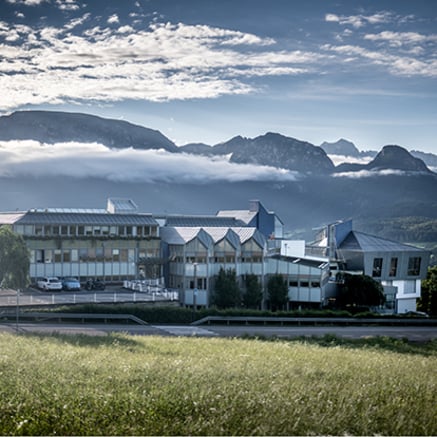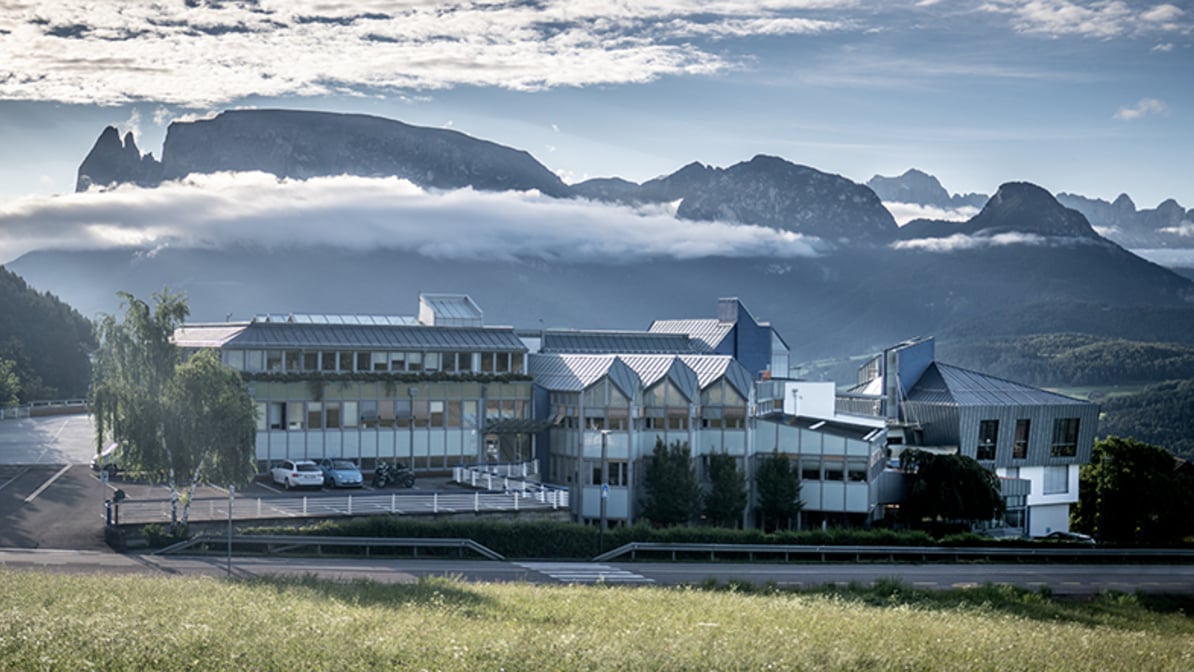
More from less.
Responsibility from the very outset. New materials are making the construction industry sustainably more sustainable.
Solar panels on the roof have long been regarded as a byword for ecological awareness. Today, buildings are no longer necessarily judged according to whether and to what extent they were planned and built to environmental standards, or how energy-efficient they are. This is due to the wide variety of new materials that are both attractive and sustainable.
Texts: Melanie Schlegel, Sabrina Lettenmaier
“It remains a conundrum,” writes architecture critic Gerhard Matzig, “why sustainable thinking and acting are so seldom found on the very terrain where the future is being decided. Namely, the area of architecture and urban planning.” And this despite the fact that, according to Matzig, “in a few decades two thirds of the world’s population will be living in cities and densely populated areas.” The United Nations now therefore speaks of the 'urban millennium'. Some 40 percent of all global CO2 emissions are already produced in buildings – buildings that have been designed by architects, urban planners and engineers.
One person who addressed this issue – long before sustainability became a political and economic buzzword – was Werner Sobek. A professor of architecture in Stuttgart, he saw as early as 1974 – just a year after the first oil crisis – that the world was heading rapidly towards a shortage of resources. He thus began to think about alternative architectural and material concepts. By 1992, to the amusement of many of his colleagues, he was giving his first lectures on “recycling- compatible design”. At the turn of the millennium Sobek built R128, his own glass and steel house, as a fully recyclable building.
His latest project, the NEST Unit UMAR in Dübendorf, Switzerland, also follows his TripleZero concept: Zero Energy, Zero Emissions, Zero Waste. The four-storey NEST research building, built in 2016 by the Swiss Federal Materials Testing and Research Institute, stands for “Next Evolution in Sustainable Building Technologies” and among other things houses the UMAR module. “With the experimental Urban Mining & Recycling unit we are demonstrating that the materials available on the market can ensure appropriate recycling,” explains Sobek. He uses the term appropriate recycling instead of sustainability, further saying: “We do not just need a building plan, but also a mining plan.” In the case of UMAR, this means that all materials in the building can be recovered, there is no waste and everything is recyclable or compostable.
Expanding sustainability
“Up until now,” says Blaine Brownell, an architect and materials researcher at the University of Minnesota, “sustainability in the construction industry meant energy efficiency and was focused on spreadsheets and environmental assessments.” But now the matter concerns more than just heating, ventilation and electricity. Finally, we have to ask: how sustainable are the building materials themselves? In Germany, 560 million tonnes – and thus 90 percent of all mineral raw materials – are used annually for the production of building materials. The German Federal Environmental Foundation calculates that the construction industry is responsible for 54 percent of all waste generated. The production of cement alone releases more CO2 emissions worldwide than are caused by global aviation.
Raw material efficiency is thus the order of the day. Werner Sobek makes this urgent need very clear: If we take construction standards in Germany as a benchmark, we would have to find around two thousand billion tonnes of building materials for all the Earth’s inhabitants. That is simply not possible, says Sobek, as there already exist shortages of certain raw materials, or they will run out in the foreseeable future. Not even Qatar, a desert state that is both sand-blessed and building-obsessed, can meet its need for concrete, and has to import it. Its own sand, rounded by the wind, is unsuitable for making concrete.
What can be done? Should we use fewer raw materials? Recycle or upcycle? Or research into new materials that not only fulfil our functional and aesthetic needs, but also meet high environmental standards? One example can be found in the sober, futuristic building of the Fraunhofer Institute in Valley, Upper Bavaria, where research is for instance conducted into Typhaboard, a building material made of bulrushes and a mineral binder that is fully compostable and can be used for load-bearing and insulating wall elements. Another example is that of phase change materials (PCMs) based on sugar alcohols for use in latent heat storage, or new types of bio-hybrid fibre-reinforced plastics...
Humans as materials researchers
We and our ancestors have always been materials researchers. It is no coincidence that entire epochs of humanity have been named after materials. What began 3.4 million years ago with the Stone Age then led – via bronze, iron and light metals such as aluminium – to the mass production of plastics and further to the semiconductor materials of the middle of the last century, also permitting materials research eventually to develop as an independent branch of science. Some 150 years ago, the first institutions were founded, such as the Prussian Royal Mechanical-Technical Research Institute in Berlin (1871) or the Institute for Testing Building Materials in Switzerland (1880). Today, more than 40 universities in Germany alone offer degrees in materials science, while another 20 institutes conduct research into how matter can be transformed into new and useful forms, how existing materials can be made into other substances, and how new, innovative materials can be invented.
Showrooms have long since been established: creative hubs of which Material ConneXion, headquartered in New York, is perhaps the best known example. A renowned address in the German-speaking world can be found in Stuttgart. The material agency raumPROBE offers over 50,000 material samples that can be admired and touched on site and researched online. Hannes Bäuerle and Joachim Stumpp, the two owners of the company that they founded in 2005, call it a “petting zoo for planners”. Bäuerle describes the change of consciousness in the construction industry as follows: “For about ten years, more and more planners have been asking for sustainable and ecological materials, whereas in the past the focus was mostly on new materials.”
Of course, the battle for sustainability is nothing new. The term first appears in the German language in the essay “Sylvicultura oeconomica”, published in 1713 by the Saxon mining administrator Hans Carl von Carlowitz. His simple message, “do not cut down more wood than can grow back”, is now on everyone’s lips as “sustainable development”. The frequent, indeed excessive use of the term ‘sustainability’ may at best lead to a clearer conscience, but not necessarily to a better world. There still, 300 years after Carlowitz, remains plenty to do. Switzerland in the year 2000 nevertheless became the first country in the world to incorporate the concept of sustainability into its constitution. When, six years later, the Global Award for Sustainable Architecture was launched in France by the architect and professor Jana Revedin, the word “sustainable” had not even been translated into French. However, at the 2016 Biennale of Architecture, Revedin discovered that half of the curators had already been awarded this prize for sustainability. Perhaps this is progress after all.
Ecological and attractive
The current epoch in the history of the world, the Anthropocene, is deemed to be the age in which humankind is for the first time the main formative force. We could also say, with Gerhard Matzig: we are living in the age of the planners. Werner Sobek, as an architect and civil engineer, has clear ideas about what his species must achieve today: “Ecological construction must be breathtakingly beautiful. It is not just a question to picking up a couple of solar panels from a hardware store and nailing them to the roof.“ Ecology and breathtakingly beautiful building no longer has to be a contradiction in terms. Now is the time to explore a new aesthetic of sustainability. This can also be seen from the numerous buildings with integrated photovoltaic systems, where the PV cell itself becomes a building material for the roof or façade cladding. This idea was implemented in the Leimbach area of Zurich, in a residential high-rise building with thin-film modules that was refurbished according to the plans of the architects Harder Haas Partner. It is an example of how new materials can inspire architects to create new designs. And that is just the beginning.
A tour through raumPROBE in Stuttgart reveals how many possibilities architects can now offer: a rose-scented decorative coating, for example; a glass ceramic illuminated in many colours with a crystalline marbled structure as a type of flooring; or a terrazzo that grabs the attention with the shredded nail varnish containers embedded in the concrete. As outlandish as these products may sound and indeed sometimes look, they all have to meet the demands of everyday life. Do the sheep’s wool acoustic panels work as they should? And what are the conceivable application scenarios for the particularly low-emission wood-based panels made of fresh spruce wood chips? Of course, this new generation of building materials is also subject to the official standards for fire and sound insulation, thermal insulation and emissions, as well as LEED, BREEAM or DGNB certifications.
Nature as a model
There now exists a new composite material, carbon concrete, a textile concrete that combines concrete and carbon fibres. It is more durable and robust than conventional concrete, but is lighter and has the capacity to revolutionise architecture: as carbon, unlike reinforced concrete, will not rust, thick layers are no longer a necessity. This saves resources and makes filigree building projects possible. This new concrete can be made from anything that contains carbon. Researchers are currently using so-called lignins, a waste product of wood processing. In 2019 the first carbon house was built on the campus of the Technical University of Dresden, where textile concrete was developed under the direction of Professor Manfred Curbach. Although each kilo produced costs twenty times more than reinforced concrete, the material savings of 75 percent and significantly longer lifespan give the economics a very different look.
Scientists at Harvard University’s Wyss Institute have developed a plastic that is only half as heavy as aluminium, yet just as strong. The material is gathered from shrimp shells. Chitin is extracted from these, thus following an important principle of modern materials science: that of using nature as a model. The result is a fabric rather like the skin of an insect that is both easy to process and biodegradable. And, since fish waste occurs worldwide, this variant is a cost-effective alternative to petroleum-based plastics. Its applications are numerous, with new ones still being discovered. Perhaps also in construction? In the production of household appliances or in medicine? We will see. This is the exciting thing about the history of new materials: we only gradually discover where and how they can be employed.
Rivals to the Creator
The Finnish designer Ville Kokkonen once said: “A designer is always both a researcher in everyday life and a futurist.” And architecture, according to Jana Revedin, who teaches in Paris, has always been a workshop, a crucible for a wide range of research institutions and a laboratory for unthinkable, indeed unimaginable models of thinking, handwork and construction. Architects and other representatives of this creative profession therefore have the task of what Matzig, drawing on the French architect Claude-Nicolas Ledoux, describes as “planners who become rivals to the Creator by making a significant contribution to the preservation of creation”. If greenhouse gas concentrations are to be reduced by up to 80 percent by the year 2050, as required by the UN Climate Council, this will in particular depend on the ancient art of building houses, says Matzig. And, in view of the many developments and research projects, the chances of architecture meeting this target may not be that bad.
Texts: Melanie Schlegel, Sabrina Lettenmaier
“It remains a conundrum,” writes architecture critic Gerhard Matzig, “why sustainable thinking and acting are so seldom found on the very terrain where the future is being decided. Namely, the area of architecture and urban planning.” And this despite the fact that, according to Matzig, “in a few decades two thirds of the world’s population will be living in cities and densely populated areas.” The United Nations now therefore speaks of the 'urban millennium'. Some 40 percent of all global CO2 emissions are already produced in buildings – buildings that have been designed by architects, urban planners and engineers.
One person who addressed this issue – long before sustainability became a political and economic buzzword – was Werner Sobek. A professor of architecture in Stuttgart, he saw as early as 1974 – just a year after the first oil crisis – that the world was heading rapidly towards a shortage of resources. He thus began to think about alternative architectural and material concepts. By 1992, to the amusement of many of his colleagues, he was giving his first lectures on “recycling- compatible design”. At the turn of the millennium Sobek built R128, his own glass and steel house, as a fully recyclable building.
His latest project, the NEST Unit UMAR in Dübendorf, Switzerland, also follows his TripleZero concept: Zero Energy, Zero Emissions, Zero Waste. The four-storey NEST research building, built in 2016 by the Swiss Federal Materials Testing and Research Institute, stands for “Next Evolution in Sustainable Building Technologies” and among other things houses the UMAR module. “With the experimental Urban Mining & Recycling unit we are demonstrating that the materials available on the market can ensure appropriate recycling,” explains Sobek. He uses the term appropriate recycling instead of sustainability, further saying: “We do not just need a building plan, but also a mining plan.” In the case of UMAR, this means that all materials in the building can be recovered, there is no waste and everything is recyclable or compostable.
Expanding sustainability
“Up until now,” says Blaine Brownell, an architect and materials researcher at the University of Minnesota, “sustainability in the construction industry meant energy efficiency and was focused on spreadsheets and environmental assessments.” But now the matter concerns more than just heating, ventilation and electricity. Finally, we have to ask: how sustainable are the building materials themselves? In Germany, 560 million tonnes – and thus 90 percent of all mineral raw materials – are used annually for the production of building materials. The German Federal Environmental Foundation calculates that the construction industry is responsible for 54 percent of all waste generated. The production of cement alone releases more CO2 emissions worldwide than are caused by global aviation.
Raw material efficiency is thus the order of the day. Werner Sobek makes this urgent need very clear: If we take construction standards in Germany as a benchmark, we would have to find around two thousand billion tonnes of building materials for all the Earth’s inhabitants. That is simply not possible, says Sobek, as there already exist shortages of certain raw materials, or they will run out in the foreseeable future. Not even Qatar, a desert state that is both sand-blessed and building-obsessed, can meet its need for concrete, and has to import it. Its own sand, rounded by the wind, is unsuitable for making concrete.
What can be done? Should we use fewer raw materials? Recycle or upcycle? Or research into new materials that not only fulfil our functional and aesthetic needs, but also meet high environmental standards? One example can be found in the sober, futuristic building of the Fraunhofer Institute in Valley, Upper Bavaria, where research is for instance conducted into Typhaboard, a building material made of bulrushes and a mineral binder that is fully compostable and can be used for load-bearing and insulating wall elements. Another example is that of phase change materials (PCMs) based on sugar alcohols for use in latent heat storage, or new types of bio-hybrid fibre-reinforced plastics...
Humans as materials researchers
We and our ancestors have always been materials researchers. It is no coincidence that entire epochs of humanity have been named after materials. What began 3.4 million years ago with the Stone Age then led – via bronze, iron and light metals such as aluminium – to the mass production of plastics and further to the semiconductor materials of the middle of the last century, also permitting materials research eventually to develop as an independent branch of science. Some 150 years ago, the first institutions were founded, such as the Prussian Royal Mechanical-Technical Research Institute in Berlin (1871) or the Institute for Testing Building Materials in Switzerland (1880). Today, more than 40 universities in Germany alone offer degrees in materials science, while another 20 institutes conduct research into how matter can be transformed into new and useful forms, how existing materials can be made into other substances, and how new, innovative materials can be invented.
Showrooms have long since been established: creative hubs of which Material ConneXion, headquartered in New York, is perhaps the best known example. A renowned address in the German-speaking world can be found in Stuttgart. The material agency raumPROBE offers over 50,000 material samples that can be admired and touched on site and researched online. Hannes Bäuerle and Joachim Stumpp, the two owners of the company that they founded in 2005, call it a “petting zoo for planners”. Bäuerle describes the change of consciousness in the construction industry as follows: “For about ten years, more and more planners have been asking for sustainable and ecological materials, whereas in the past the focus was mostly on new materials.”
Of course, the battle for sustainability is nothing new. The term first appears in the German language in the essay “Sylvicultura oeconomica”, published in 1713 by the Saxon mining administrator Hans Carl von Carlowitz. His simple message, “do not cut down more wood than can grow back”, is now on everyone’s lips as “sustainable development”. The frequent, indeed excessive use of the term ‘sustainability’ may at best lead to a clearer conscience, but not necessarily to a better world. There still, 300 years after Carlowitz, remains plenty to do. Switzerland in the year 2000 nevertheless became the first country in the world to incorporate the concept of sustainability into its constitution. When, six years later, the Global Award for Sustainable Architecture was launched in France by the architect and professor Jana Revedin, the word “sustainable” had not even been translated into French. However, at the 2016 Biennale of Architecture, Revedin discovered that half of the curators had already been awarded this prize for sustainability. Perhaps this is progress after all.
Ecological and attractive
The current epoch in the history of the world, the Anthropocene, is deemed to be the age in which humankind is for the first time the main formative force. We could also say, with Gerhard Matzig: we are living in the age of the planners. Werner Sobek, as an architect and civil engineer, has clear ideas about what his species must achieve today: “Ecological construction must be breathtakingly beautiful. It is not just a question to picking up a couple of solar panels from a hardware store and nailing them to the roof.“ Ecology and breathtakingly beautiful building no longer has to be a contradiction in terms. Now is the time to explore a new aesthetic of sustainability. This can also be seen from the numerous buildings with integrated photovoltaic systems, where the PV cell itself becomes a building material for the roof or façade cladding. This idea was implemented in the Leimbach area of Zurich, in a residential high-rise building with thin-film modules that was refurbished according to the plans of the architects Harder Haas Partner. It is an example of how new materials can inspire architects to create new designs. And that is just the beginning.
A tour through raumPROBE in Stuttgart reveals how many possibilities architects can now offer: a rose-scented decorative coating, for example; a glass ceramic illuminated in many colours with a crystalline marbled structure as a type of flooring; or a terrazzo that grabs the attention with the shredded nail varnish containers embedded in the concrete. As outlandish as these products may sound and indeed sometimes look, they all have to meet the demands of everyday life. Do the sheep’s wool acoustic panels work as they should? And what are the conceivable application scenarios for the particularly low-emission wood-based panels made of fresh spruce wood chips? Of course, this new generation of building materials is also subject to the official standards for fire and sound insulation, thermal insulation and emissions, as well as LEED, BREEAM or DGNB certifications.
Nature as a model
There now exists a new composite material, carbon concrete, a textile concrete that combines concrete and carbon fibres. It is more durable and robust than conventional concrete, but is lighter and has the capacity to revolutionise architecture: as carbon, unlike reinforced concrete, will not rust, thick layers are no longer a necessity. This saves resources and makes filigree building projects possible. This new concrete can be made from anything that contains carbon. Researchers are currently using so-called lignins, a waste product of wood processing. In 2019 the first carbon house was built on the campus of the Technical University of Dresden, where textile concrete was developed under the direction of Professor Manfred Curbach. Although each kilo produced costs twenty times more than reinforced concrete, the material savings of 75 percent and significantly longer lifespan give the economics a very different look.
Scientists at Harvard University’s Wyss Institute have developed a plastic that is only half as heavy as aluminium, yet just as strong. The material is gathered from shrimp shells. Chitin is extracted from these, thus following an important principle of modern materials science: that of using nature as a model. The result is a fabric rather like the skin of an insect that is both easy to process and biodegradable. And, since fish waste occurs worldwide, this variant is a cost-effective alternative to petroleum-based plastics. Its applications are numerous, with new ones still being discovered. Perhaps also in construction? In the production of household appliances or in medicine? We will see. This is the exciting thing about the history of new materials: we only gradually discover where and how they can be employed.
Rivals to the Creator
The Finnish designer Ville Kokkonen once said: “A designer is always both a researcher in everyday life and a futurist.” And architecture, according to Jana Revedin, who teaches in Paris, has always been a workshop, a crucible for a wide range of research institutions and a laboratory for unthinkable, indeed unimaginable models of thinking, handwork and construction. Architects and other representatives of this creative profession therefore have the task of what Matzig, drawing on the French architect Claude-Nicolas Ledoux, describes as “planners who become rivals to the Creator by making a significant contribution to the preservation of creation”. If greenhouse gas concentrations are to be reduced by up to 80 percent by the year 2050, as required by the UN Climate Council, this will in particular depend on the ancient art of building houses, says Matzig. And, in view of the many developments and research projects, the chances of architecture meeting this target may not be that bad.
Durat
A cake dish made of plastic waste? It looks better than it sounds. When the Finnish company Durat started producing mineral substances in 1990, it had the clear objective of developing a new, sustainable material. From this idea came a simple recipe for Durat: a base mix of polyester is mixed with small pieces of shredded old plastic from Sweden and Finland. Durat-Palace uses only natural pigments made from earth colours. The proportion of recycled material is ultimately about 30 percent. Durat and Durat-Palace are waterproof and very robust: they can be glued, sawed, screwed or bent and are often used in wet areas for sinks, showers and bathtubs, or in outdoor furniture in the form of tables, chairs and benches. Even crockery was created using Durat-Palace for the “Zero Waste Bistro”, a popup restaurant made of recycled food packaging. All Durat products can be returned to the manufacturer at the end of their life and fully recycled.
Urban Terrazzo
The inventors of Urban Terrazzo are known as “They Feed off Buildings”: a design and architecture collective that, as the name suggests, feeds off buildings. What does this mean? Instead of sending the enormous amounts of rubble from demolition works to landfill, the concrete, bricks and other building materials produced are crushed and smoothed. These fragments are then placed in a mould with soft concrete that has previously been coloured with ground-up bricks. After the tiles have been dried and smoothed, what used to be rubble can then be used as a unique mosaic for floors or bathroom walls.
Pentatonic
“Molecules live forever,” say the furniture makers and inventors of the Pentatonic material. Coffee cups, soft drink cans, shirts or plastic bottles may well have short useful lives – but can have second, third or fourth lives when converted into new forms. Everyday rubbish, for example, can be turned into breathable felt, strong carbon textiles or extremely scratch-resistant glass. Pentatonic experiments and designs with everything we throw out as waste, whether design furniture, crockery or textiles. Smartphone glass is melted down to make scratch-resistant, dishwasher-safe crockery. Cocktail stirrers become barstools. Frappuccino cups, once used, can become a recycled version of the well-known Starbucks “Bean Chair”.
A cake dish made of plastic waste? It looks better than it sounds. When the Finnish company Durat started producing mineral substances in 1990, it had the clear objective of developing a new, sustainable material. From this idea came a simple recipe for Durat: a base mix of polyester is mixed with small pieces of shredded old plastic from Sweden and Finland. Durat-Palace uses only natural pigments made from earth colours. The proportion of recycled material is ultimately about 30 percent. Durat and Durat-Palace are waterproof and very robust: they can be glued, sawed, screwed or bent and are often used in wet areas for sinks, showers and bathtubs, or in outdoor furniture in the form of tables, chairs and benches. Even crockery was created using Durat-Palace for the “Zero Waste Bistro”, a popup restaurant made of recycled food packaging. All Durat products can be returned to the manufacturer at the end of their life and fully recycled.
Urban Terrazzo
The inventors of Urban Terrazzo are known as “They Feed off Buildings”: a design and architecture collective that, as the name suggests, feeds off buildings. What does this mean? Instead of sending the enormous amounts of rubble from demolition works to landfill, the concrete, bricks and other building materials produced are crushed and smoothed. These fragments are then placed in a mould with soft concrete that has previously been coloured with ground-up bricks. After the tiles have been dried and smoothed, what used to be rubble can then be used as a unique mosaic for floors or bathroom walls.
Pentatonic
“Molecules live forever,” say the furniture makers and inventors of the Pentatonic material. Coffee cups, soft drink cans, shirts or plastic bottles may well have short useful lives – but can have second, third or fourth lives when converted into new forms. Everyday rubbish, for example, can be turned into breathable felt, strong carbon textiles or extremely scratch-resistant glass. Pentatonic experiments and designs with everything we throw out as waste, whether design furniture, crockery or textiles. Smartphone glass is melted down to make scratch-resistant, dishwasher-safe crockery. Cocktail stirrers become barstools. Frappuccino cups, once used, can become a recycled version of the well-known Starbucks “Bean Chair”.
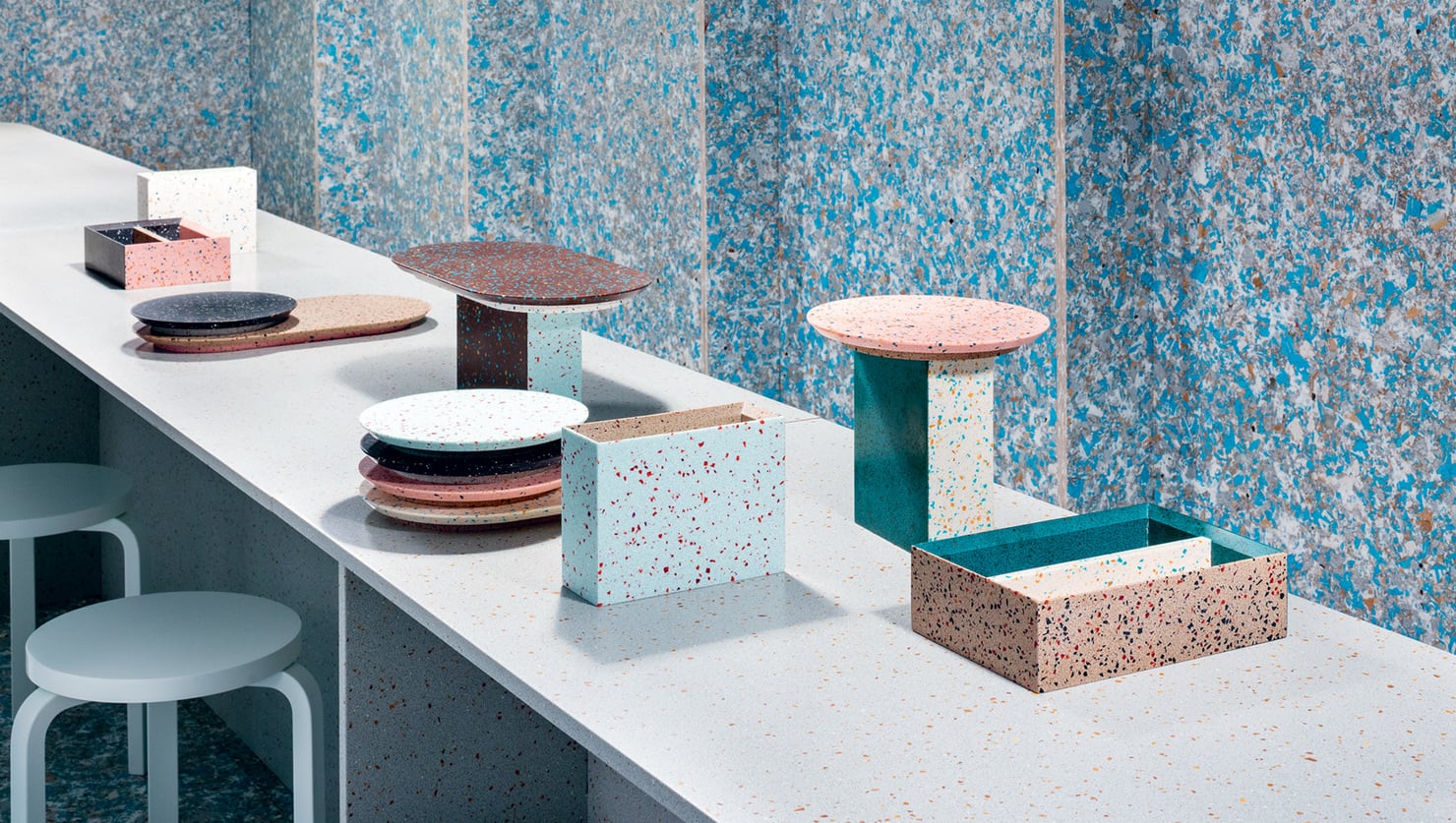
A cake dish made of plastic waste? From this idea came a simple recipe for Durat: a base mix of polyester is mixed with small pieces of shredded old plastic.
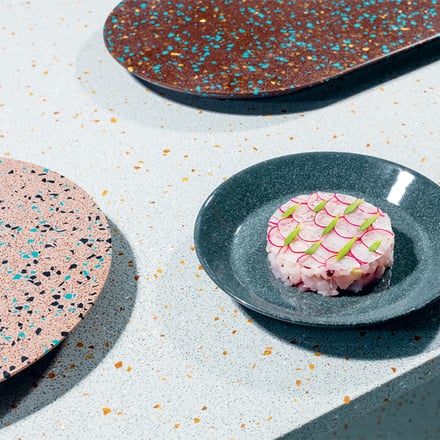
All Durat products can be returned to the manufacturer at the end of their life and fully recycled.
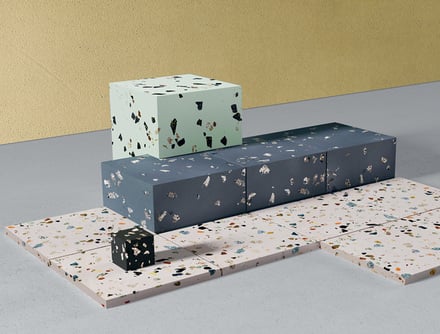
Instead of sending the enormous amounts of rubble from demolition works to landfill, the concrete, bricks and other building materials produced are crushed and smoothed. These fragments are then placed in a mould with soft concrete that has previously been coloured with ground-up bricks.
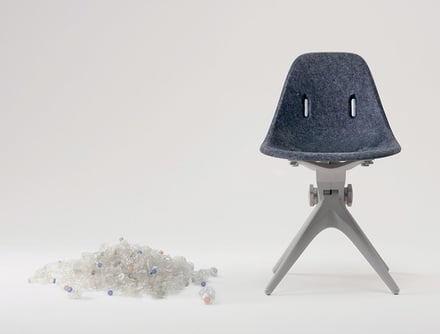
Frappuccino cups, once used, can become a recycled version of the well-known Starbucks “Bean Chair”.

“Molecules live forever,” say the furniture makers and inventors of the Pentatonic material. Coffee cups, soft drink cans, shirts or plastic bottles may well have short useful lives – but can have second, third or fourth lives when converted into new forms.
Still want more?
See here for further interesting reading matter.


Department of Gestaltungslehre and Design – Technical University of Vienna.
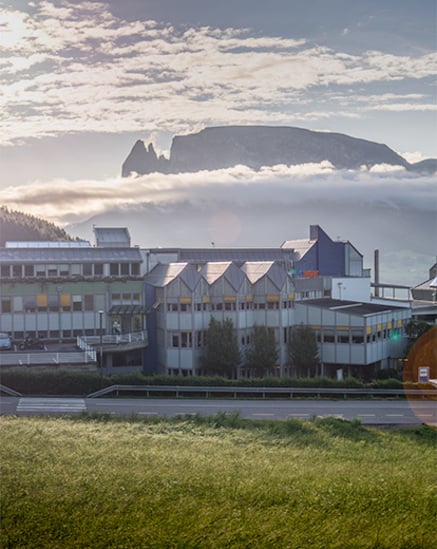
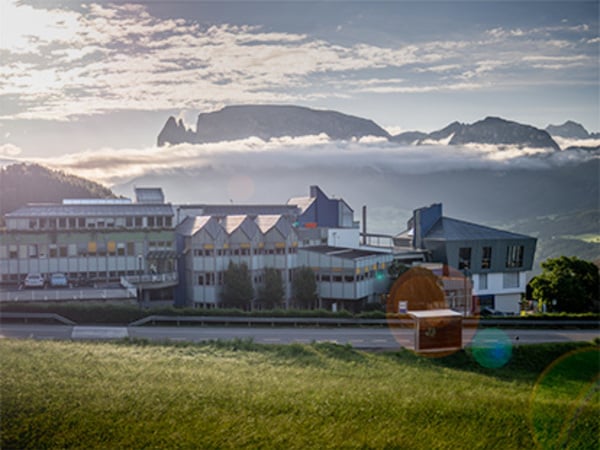
The South-Tyrolean family business is among the biggest window suppliers in Europe.
